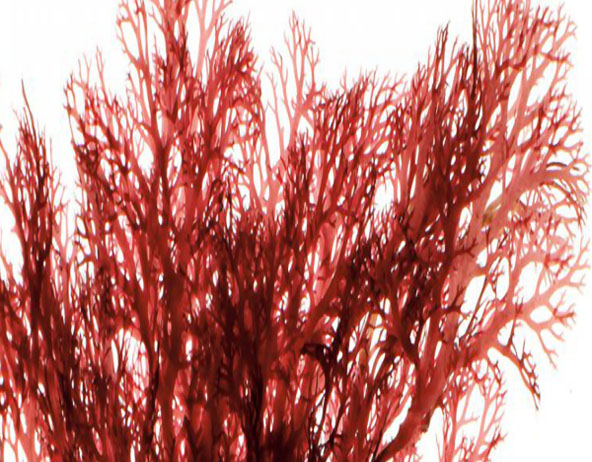
L. calcareum is widely sold in Ireland and France, where it is abundant in the form of maerl beds. Besides selected European suppliers, a Brazilian seller of micronized L. calcareum powder has been identified for this report. L. calcareum extract is sold by suppliers from Mexico, South Korea, India and an ample number of Chinese companies.
There are numerous claims of sustainable harvesting, however sub-aquatic mining essentially destroys the beds due to extremely slow growth of the alga. Therefore conservation attempts are in progress.
Description
Fragile coralline seaweed which grows together with and is often confused with Lithothamnion corallioides. It can take a rare attached crustose form or unattached branching shape. Fragmentation is common. Unattached thalli can appear in a wide range of sizes and shapes.
It is most often found in sheltered areas less than 20 meters deep, but with moderate water flow. Substrate types are variable from sand to mud. This species is usually found in expansive “maerl beds” – a unique ecosystem composed of L. calcareum together with either L. corallioides or L. glaciale, two calcareous red alga that share similar growth patterns. It is extremely slow growing, but may live up to 100 years old. Live thalli grow on top of dead individuals, creating a complex habitat.
https://seaweedindustry.com/seaweed/type/phymatolithan-calcareum
Common names
Chalk weed, coral strands, knollige Kalkalge, lithothamne, maerl
Nutrition facts
|
MESH |
Less than 200 mesh |
|
IRON |
0.25% |
|
MAGNESIUM |
1.7-3.3% |
|
CALCIUM |
25-33% |
Distribution
By Algabase (sources listed):
Ireland – Antrim, Cork, Donegal, Galway, Kerry, Mayo
Europe – Adriatic Sea, Balearic Islands, Britain, France, Greece, Ireland, Italy, Spain
Atlantic Islands – Madeira
South America – Chile
New Zealand
Antarctic and the subantarctic Islands – Fuegia
http://www.algaebase.org/search/species/detail/?species_id=n306fea7e402320dd&sk=0&from=results
By Seaweed Industry Association:
L. calcareum stretches as far north as the Arctic Sea and as far south as the Canary Islands. It grows in the western Baltic, the North Sea and from Norway down through the English Channel to northern Spain and Portugal and into the Mediterranean. It is abundant and widely distributed on the southern and western coasts of the UK. https://seaweedindustry.com/seaweed/type/phymatolithan-calcareum
Druet at al mapped the seabed in the Menorca Channel (western Mediterranean). Mearl accounted for at least 13.3% of the investigated seafloor. The Menorca Channel is on the high priority list to be included in the EU Nature 2000 Network.
The Marine Life Information Network provides a map of L. Calcareum distribution along the coast of Britain and Ireland. http://www.marlin.ac.uk/speciesinformation.php?speciesID=4121
A 2007 UK report on the conservation status of maerl identifies the condition of maerl beds as deteriorating with poor future prospects due to human activities.
http://jncc.defra.gov.uk/pdf/Article17/FCS2007-S1376-audit-Final.pdf
The British Geological Survey Report evaluates distribution of maerl deposits around the Falkland Islands, known there as “calcified seaweed”, and most likely constituting of multiple species. http://nora.nerc.ac.uk/505277/1/CR03148N.pdf
The Convention of the Marine Environment of the North East Atlantic (OSPAR) maps maerl areas in the region. Unpublished reports of maerl in fjordic locations of Greenland and Spitzbergen are mentioned in the assessment. http://qsr2010.ospar.org/media/assessments/Species/P00491_maerl.pdf
Use
L. calcareum (as a major component of maerl) has been used historically as a soil conditioner as well as food additive for livestock. And a filtration medium for acidic drinking water. Modern uses include cosmetics and supplements. It is also used in agricultural, horticultural and medical industries.
Irish maerl
According to the Seaweed Site, over 500 000 tons of maerl is collected in Brittany (France), dried, ground and sold for agricultural purposes. Harvesting in Cornwall has largely ceased, and although licenses have been awarded in Scotland, these do not seem to have taken up. Extensive subtidal beds are found all along the west coast of Ireland, particularly in the larger bays. The greatest concentration – about 8 milion wet tons of maerl is within the inner and outer reaches of Galway Bay. However, the site lists Phymatolithon purpureum and Lithothamnion coralloides as the main species. But it should be noted that according to Algabase, Lithothamnion calcareum and L. corallioides are frequently confused. http://www.seaweed.ie/uses_ireland/irishmaerl.php It is further noted that P. purpureum and L. corallioides are subject to “management measures” in the EU Habitats Directive.
In several places, notably in Co Galway at Tra an Doilin near An Cheathru Rua (Coral Beach or Coral Strand, Carreroe, Co Galway) and at Ballyconneely (Mannin Bay), Co Galway, sufficient dead mearl is cast up, so that the beach is formed of broken-up fragments.
Subtidal deposits of maerl that are entirely dead are found in a number of places, including the upper reaches of bays, such as Bantry Bay.
Brazil
According to it is presumed that the larges rhodolith beds are to be found on the Brazilian coast. Estimates indicate that these beds cover extensive area of the N-NE Brazilian continental shelf. The beds remain poorly studied.
A new law is proposed in Brazil to regulate sub aquatic mining, currently under general mining law.
http://ruschicolibri.com.br/ing/sub_aquatics_ing.php
Consumer Products/Supplements/Body Care
L. calcareum is being widely sold as a calcium supplement. The site promoting such use provides the mineral content of L. clcareum:
http://saarith.hubpages.com/hub/Is-algae-calcium-better
Numerous studies on the effect of L. calcareum on health refer to L. calcareum supplement marketed under the name Vitality 50+ in Brazil and other countries. For example in this study:
The International Trademark Records indicate that a trademark application was filed for Vitality 50+ in January 2006, but it was later abandoned.
http://www.markhound.com/trademark/search/KwUfDf9Cr
WE HAVE THIS AVAILABLE ON https://seatechbioproducts.com/maerl-calcified-seaweed-lithothamnium-calcareum-human-nutrition-powder-25kg.html?